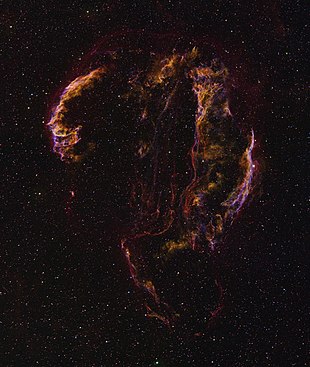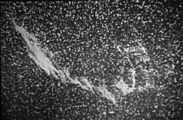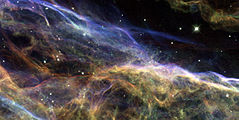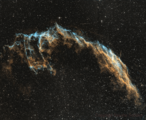Cirrus nebula
| Emission nebula | |
|---|---|
| Cirrus nebula ( supernova remnant )
|
|

|
|
| Recorded using a line filter for ionized gases: Hα, SII, OIII The light-colored filament on the left above the middle is designated NGC 6992 and 6995, the adjacent structure below with IC 1340; the right light filament with NGC 6960 and the star next to it with 52 Cygni . The two filaments in between bear the designation NGC 6974 (above, in the middle) and to the right of it, slightly lighter and larger, NGC 6979. |
|
| AladinLite | |
| Constellation | swan |
|
Position equinox : J2000.0 , epoch : J2000.0 |
|
| Right ascension | 20 h 45 m 38.0 s |
| declination | + 30 ° 42 ′ 30 ″ |
| Appearance
|
|
| Apparent brightness (visual) | 7.0 likes |
| Angular expansion | 3 ° |
| Ionizing source | |
| Physical data
|
|
| distance | 735 pc |
| diameter | 150 × 120 ly |
|
history
|
|
| discovery | Wilhelm Herschel |
| Date of discovery | September 5, 1784 |
| Catalog names | |
| NGC 6960, 6974, 6979, 6992, 6995 • IC 1340 • GC 4600, 5975, 4607, 4616, 4618 • H V 15, II 206, V 14 • h 2088, 2092, 2093 • Caldwell 33/34 • Ced 182 | |
The Cirrus fog (also known as fog mist , English Veil nebula hereinafter) is the visible part of the spectrum in the optical Cygnusbogens , a collection of emission and reflection nebulae , which is at a distance of about 2,400 light-years in the constellation Cygnus located. Together they are the remnant of a supernova that took place around 8,000 years ago. Various parts of the remnant have different NGC and IC numbers. The objects NGC 6960 , NGC 6974 , NGC 6979 , NGC 6992 , NGC 6995 and IC 1340 all belong to the same structure.
| Name of the object | Right ascension | declination | m V | Angular expansion | Explorer | Discovery date |
|---|---|---|---|---|---|---|
| NGC 6960 | 20 h 45 m 58.2 s | + 30 ° 45 ′ 43 ″ | 70.00 × 6.0 | William Herschel | September 7, 1784 | |
| NGC 6974 | 20 h 51 m 04.3 s | + 31 ° 49 ′ 41 ″ | Lawrence Parsons | August 20, 1873 | ||
| NGC 6979 | 20 h 50 m 28.0 s | + 32 ° 01 ′ 33 ″ | 7.00 × 3.0 | William Herschel | September 7, 1784 | |
| NGC 6992 | 20 h 56 m 19.1 s | + 31 ° 44 ′ 34 ″ | 60.00 × 8.0 | William Herschel | September 5, 1784 | |
| NGC 6995 | 20 h 57 m 10.7 s | + 31 ° 14 ′ 07 ″ | 12.00 × 12.0 | John Herschel | September 7, 1825 | |
| IC 1340 | 20 h 56 m 08.2 s | + 31 ° 02 ′ 52 ″ | 25.00 × 20.0 | Truman Henry Safford | September 13, 1866 |
The nebula was discovered by William Herschel on September 5, 1784 . He described it as: “Extended; passes thro '52 Cygni ... near 2 degree in length “; the eastern part as "Branching nebulosity ... The following part divides into several streams uniting again towards the south."
Investigations
The first photographs were taken and published by Isaac Roberts at the end of the 19th century . Despite its total brightness of about 7 mag, the nebula is not easy to observe for amateur astronomers because of its large area of 230 ′ × 160 ′ ; Contrast- increasing fog filters are helpful . In photographs, especially in the short-wave spectral range, the fog stands out clearly.
Image of a filament (NGC 6992, 6995) from Roberts with a 50 cm Newtonian telescope , 1899
Numerous studies on the structure and gas dynamics of supernova remnants have been and are being carried out on him , for example detailed studies with the Hubble space telescope . Photographs in different wavelength ranges, especially in the X-ray range by the ROSAT satellite , result in an overall picture of the nebula that is reminiscent of a light bulb in its outlines. The compact remnant ( neutron star , pulsar or black hole ) of the supernova is not known.
Web links
- Long exposure amateur shot
- Narrow band recording (HA / OIII) with a 16 inch Newtonian telescope
- Spektrum.de : Collection of amateur recordings
Individual evidence
- ↑ SIMBAD Astronomical Database. In: Results for Veil Nebula. Retrieved January 2, 2007 .
- ↑ SEDS: NGC 6960
- ↑ a b Robert A. fez, Kathryn E. Weil, Ignacio A. Cisneros, William P. Blair, John C. Raymond: The Cygnus Loop's distance, properties, and environment driven morphology . In: Monthly Notices of the Royal Astronomical Society . tape 481 , no. 2 , 2018, p. 1786-1798 , doi : 10.1093 / mnras / sty2370 .
- ^ [email protected]: Revisiting the Veil Nebula. Retrieved June 6, 2017 (UK English).
- ↑ a b Searching NED. In: NASA / IPAC EXTRAGALACTIC DATABASE. Retrieved May 1, 2019 .
- ↑ Seligman: NGC 6960
- ↑ Seligman: NGC 6974
- ↑ Seligman: NGC 6979
- ↑ Seligman: NGC 6992
- ↑ Seligman: NGC 6995
- ↑ Seligman: IC 1340
- ↑ A High-resolution X-ray Image of the Cygnus Loop. NASA's High Energy Astrophysic Science Archive Research Center.
- ^ Veil Nebula (X-rays).
- ↑ B. Uyanıker, W. Reich, A. Yar, R. Kothes, E. Fürst: Is the Cygnus Loop two supernova remnants? bibcode : 2002A & A ... 389L..61U .
- ^ William P. Blair, Ravi Sankrit, John C. Raymond: Hubble Space Telescope Imaging of the Primary Shock Front in the Cygnus Loop Supernova Remnant. (PDF; 1.1 MB), The Astronomical Journal, 129: 2268-2280, 2005.
- ↑ Ravi Sanskrit, William P. Blair, John C. Raymond, Knox S. Long: Hubble Space Telescope STIS Observations of the Cygnus Loop: Spatial Structure of a Nonradiative Shock. (PDF; 306 kB), The Astronomical Journal, 120: 1925–1932, 2000.





